As a home cook who grew up in the bustling streets of Bantan Munti in Bataan, recreating the perfect Filipino Fish Ball recipe became my passion project during the pandemic. These golden, springy delights – a cornerstone of Filipino street food culture – bring back memories of afternoon dismissal bells and the familiar call of "Fish ball! Fish ball!" echoing through our neighborhood streets.
After countless attempts to capture that authentic manong's fish ball recipe, I've finally mastered the perfect balance of bounce, crunch, and that signature sweet-spicy sauce that makes this merienda favorite irresistible.
This homemade version elevates the humble street food classic into a restaurant-worthy snack while maintaining its soul-satisfying comfort. Using fresh fish and traditional pounding techniques, these fish balls achieve that coveted texture: crispy outside, tender inside – that street food aficionados dream about.
Whether you're missing your favorite street food vendor or wanting to create a healthier version at home, this tested and perfected recipe brings the beloved kanto experience right to your kitchen.
Jump to:
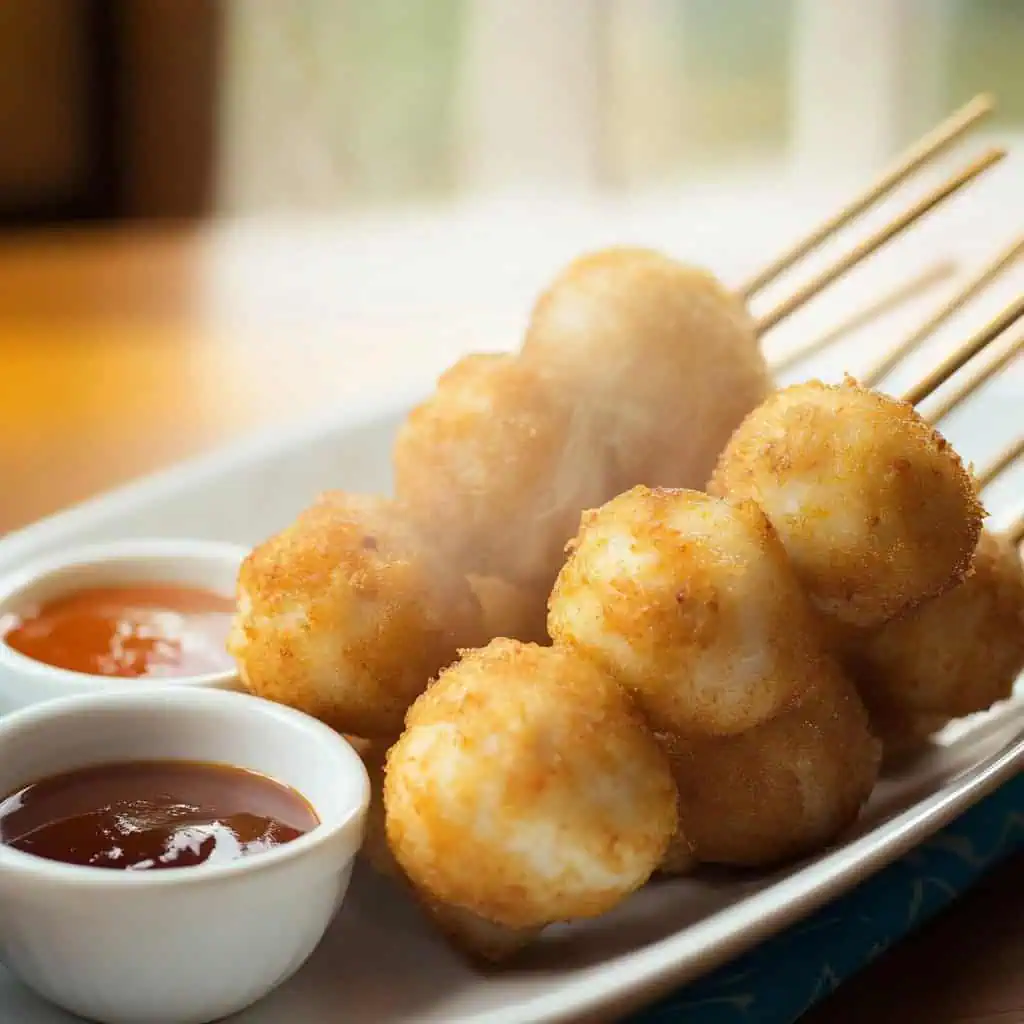
Why You'll Love This Recipe
- Authentic Street Food Taste: Recreate that classic manong's (vendor's) fish ball flavor at home
- Budget-Friendly: Cheaper than your daily milk tea habit
- Customizable: Adjust the spice level and sauce thickness to your preference
- Perfect Texture: Learn the secret to achieving that signature "bounce" (pagkamalabot)
- Family-Approved: Guaranteed to make everyone run to the kitchen faster than when you announce "libre ko!" (my treat!)
Ingredients
This recipe uses pollock or cream dory fish for their mild flavor and perfect texture when processed. The cornstarch is essential for creating that signature bounce, while salt enhances the seafood taste and sugar adds subtle sweetness.
In the sauce, the combination of soy sauce, garlic, shallots, and chilies creates a complex flavor profile that balances sweet, salty, and spicy notes. Brown sugar caramelizes slightly when heated, giving the sauce its distinctive street-food depth, while flour and cornstarch ensure the perfect consistency for clinging to each bite.
Together, these ingredients recreate the authentic Filipino fish ball experience that combines comfort, nostalgia, and bold flavors in every golden, bouncy bite.
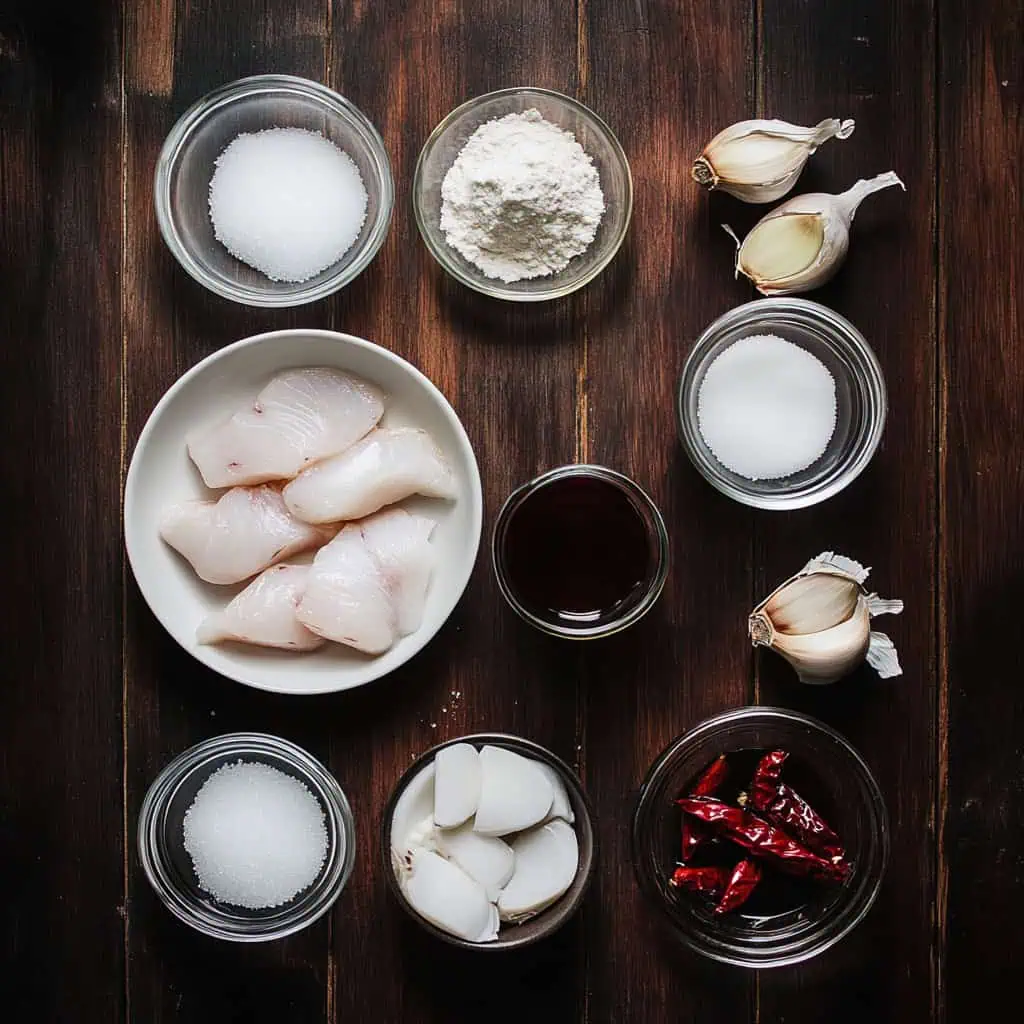
For the Fish Balls:
- 1 pound (500g) fish flesh (preferably pollock or cream dory)
- 2 tablespoons cornstarch
- 2 teaspoons salt
- 1 teaspoon sugar
- ¼ cup cold water
- Canola oil for frying
For Manong's Special Sauce:
- 2 cups water
- ⅓ cup soy sauce
- 1 head garlic, peeled and minced
- 3 shallots, peeled and finely chopped
- 4 Thai chili peppers
- 1 cup brown sugar
- 1 tablespoon all-purpose flour
- 1 tablespoon cornstarch
- 1 teaspoon salt
- ½ teaspoon pepper
Equipment
For Preparation:
- Food processor - Essential for grinding the fish into a smooth paste
- Large mixing bowl - For mixing and pounding the fish paste
- Digital thermometer - Ensures precise cooking temperatures for perfect texture
- Measuring cups and spoons - For accurate ingredient proportions
For Cooking:
- Deep pot or fryer - Provides even heat distribution for frying
- Spider strainer or slotted spoon - Makes removing fish balls from oil easy
- Paper towels - Absorbs excess oil after frying
- Small saucepan - For preparing the sweet-spicy sauce
- Bamboo skewers - Creates the authentic "tusok-tusok" experience

How To Make
- Clean your fresh fish thoroughly and remove all bones. Cut the fish into small chunks and keep them very cold, below 40°F/4°C.
- Place the cold fish chunks into your food processor and grind until it becomes a smooth paste. Transfer the fish paste to a large mixing bowl.
- Add 2 tablespoons cornstarch, 2 teaspoons salt, 1 teaspoon sugar, and ¼ cup ice-cold water to the fish paste. Mix these ingredients together until well combined.
- Now comes the important traditional pounding technique. Lift the mixture and forcefully slam it back into the bowl. Continue this pounding motion for about 15 minutes or approximately 100 times. The mixture will become smooth and glossy and should pull away cleanly from the sides of the bowl. Keep the mixture cold throughout this process, ideally below 50°F/10°C.
- While pounding the fish paste, prepare the sauce. In a pot, combine 2 cups water, ⅓ cup soy sauce, 1 minced head of garlic, 3 finely chopped shallots, 4 chopped Thai chilies, 1 cup brown sugar, 1 tablespoon all-purpose flour, 1 tablespoon cornstarch, 1 teaspoon salt, and ½ teaspoon ground black pepper.
- Heat the sauce mixture to 200°F/93°C while stirring constantly. Simmer for 3-5 minutes until it thickens. Remove from heat and let it cool to room temperature.
- Return to your fish paste mixture. Wet your hands with cold water and shape the mixture into 1-inch balls. Place the shaped balls on a clean plate.
- Bring a pot of water to exactly 175°F/80°C. Carefully drop the fish balls into the hot water and cook until they float to the surface, about 1-2 minutes. Remove them with a strainer and let them cool completely.
- Heat cooking oil in a deep pan to 350°F/175°C. Fry the cooled fish balls in small batches, 8-10 pieces at a time, until golden brown. Don't overcrowd the pan. Remove and drain on paper towels.
- If you want extra crispy fish balls, you can double-fry them. After the first frying, let them cool for 2 minutes, then fry again at 350°F/175°C for 30 seconds.
- Serve immediately while hot and crispy, with the prepared sauce on the side for dipping. For the authentic street food experience, serve them skewered on bamboo sticks.

Tips from Lola's Kitchen
- Temperature control is crucial - Keep fish cold throughout preparation for the best texture
- Pounding properly - The more vigorously you pound, the bouncier your fish balls will be
- Test batch first - Always cook one fish ball to test consistency before shaping the entire batch
- Wet hands technique - Keep your hands slightly wet while shaping to prevent sticking
- Proper frying depth - Ensure oil is at least 2 inches deep for even cooking
- Quality ingredients matter - Use the freshest fish possible for authentic flavor
- Pay attention to timing - Don't overcook when boiling or they'll lose their signature bounce
Substitutions
- Fish options: Instead of pollock or cream dory, you can use mackerel (galunggong), round scad, or tilapia
- Cornstarch alternative: Potato starch works well as a 1:1 replacement
- Thai chilies substitute: Regular red chilies or even jalapeños (adjust quantity for heat preference)
- Brown sugar replacement: Use white sugar with a teaspoon of molasses, or pure white sugar (though it will alter the flavor slightly)
- Shallot substitute: Red onions finely minced can work in a pinch
- Oil alternatives: Any neutral high-heat oil like vegetable or peanut oil will work
Troubleshooting
- Fish balls too soft? Add more cornstarch, one teaspoon at a time, until the consistency firms up
- Not bouncy enough? The mixture needs more vigorous pounding to develop elasticity
- Breaking apart while cooking? Either your water is too hot or the mixture is too loose with inadequate binding
- Fish balls not floating during boiling? Your water temperature is likely not hot enough - aim for exactly 175°F/80°C
- Sauce too thin? Simmer longer or add a bit more cornstarch mixed with cold water
- Sauce too thick? Add water a tablespoon at a time until desired consistency is reached
- Fishy smell too strong? Soak fish in milk for 30 minutes before processing to neutralize odors
Storage & Reheating
- Refrigerator storage: Keep cooked fish balls in an airtight container for up to 3-4 days
- Freezer storage: Uncooked shaped fish balls can be frozen for up to 3 months - freeze them on a tray first, then transfer to freezer bags
- Thawing: Always thaw frozen fish balls completely in the refrigerator before cooking
- Sauce storage: The sauce keeps for up to 1 week when refrigerated in an airtight container
- Reheating cooked fish balls: For best texture, refry for 30-45 seconds in hot oil at 350°F
- Alternative reheating: You can microwave for 20-30 seconds, but they won't be as crispy
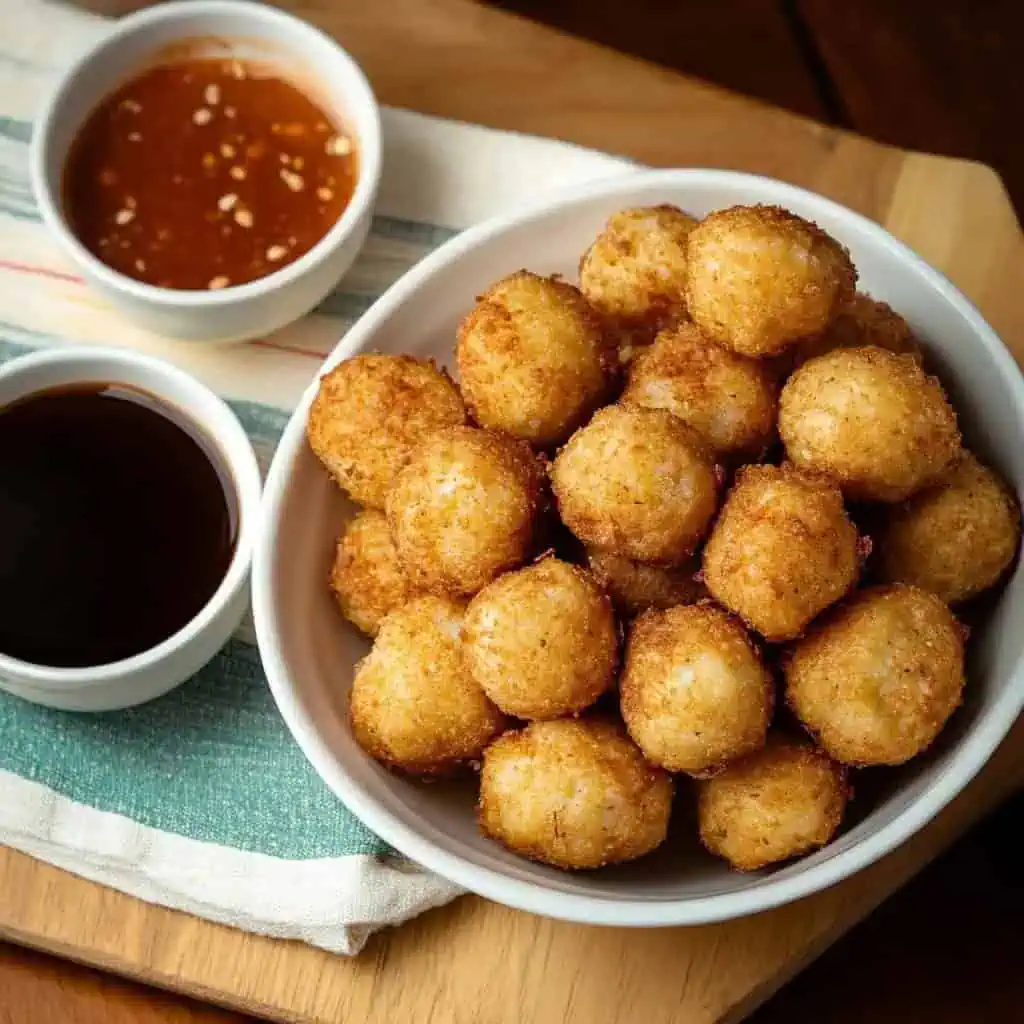
FAQ
Why aren't my fish balls bouncy like the street vendors' version?
The key to bounce is in the pounding technique. You must vigorously pound the mixture for at least 15 minutes and maintain cold temperatures throughout.
Can I use frozen fish instead of fresh?
Yes, but thaw it completely and pat it dry before processing. Fresh fish will give better texture and flavor.
Is it necessary to boil the fish balls before frying?
Yes, the pre-boiling process is essential for developing the proper internal texture before creating the crispy exterior.
How do I know when the fish balls are properly cooked?
During the boiling stage, they'll float to the surface when done. When frying, they should be evenly golden brown.
Can I make the fish balls ahead of time for a party?
Yes! Shape them, boil them, then refrigerate up to a day ahead. Fry them just before serving.
Can I air fry these instead of deep frying?
Yes, spray with oil and air fry at 400°F for 8-10 minutes, shaking the basket halfway through. The texture will be slightly different but still delicious.
Why is my sauce separating after storage?
This is normal. Just reheat gently while stirring to recombine the ingredients.
How can I make these healthier?
You can bake them at 425°F for 15-20 minutes after boiling instead of frying. Brush with a little oil for browning.
What makes authentic fish balls different from store-bought ones?
Homemade versions use a much higher ratio of fish to fillers, creating better flavor and texture. Commercial versions often contain more starch than fish.
Can I double the recipe?
Yes, but work in batches when pounding to maintain the proper texture.
Related
Looking for other recipes like this? Try these:

Authentic Homemade Filipino Fish Balls (Tusok-Tusok)
Ingredients
For the Fish Balls (Bola-bola ng Isda)
- 1 pound 500g fish flesh (laman ng isda) - preferably pollock or cream dory
- 2 tablespoons cornstarch
- 2 teaspoons salt asin
- 1 teaspoon sugar asukal
- ¼ cup cold water malamig na tubig
- Canola oil for frying mantika
For Manong's Special Sauce (Espesyal na Sawsawan)
- 2 cups water tubig
- ⅓ cup soy sauce toyo
- 1 head garlic peeled and minced (bawang, tinadtad)
- 3 shallots peeled and finely chopped (sibuyas tagalog)
- 4 Thai chili peppers siling labuyo
- 1 cup brown sugar
- 1 tablespoon all-purpose flour harina
- 1 tablespoon cornstarch gawgaw
- 1 teaspoon salt asin
- ½ teaspoon pepper paminta
Instructions
- First, clean your fresh fish thoroughly and remove all bones (Linisin at tanggalin lahat ng tinik ng isda). Cut the fish into small chunks and keep them very cold, below 40°F/4°C (Putulin ng maliliit at panatilihing malamig).
- Place the cold fish chunks into your food processor and grind until it becomes a smooth paste (Gilingin ang isda hanggang maging paste). Transfer the fish paste to a large mixing bowl.
- Add 2 tablespoons cornstarch, 2 teaspoons salt (asin), 1 teaspoon sugar (asukal), and ¼ cup ice-cold water (malamig na tubig) to the fish paste. Mix these ingredients together until well combined (Haluing mabuti).
- Now comes the important traditional pounding technique. Lift the mixture and forcefully slam it back into the bowl. Continue this pounding motion for about 15 minutes or approximately 100 times. The mixture will become smooth and glossy (makintab) and should pull away cleanly from the sides of the bowl. Keep the mixture cold throughout this process, ideally below 50°F/10°C.
- While pounding the fish paste, prepare the sauce (Ihanda ang sawsawan). In a pot, combine 2 cups water (tubig), ⅓ cup soy sauce (toyo), 1 minced head of garlic (tinadtad na bawang), 3 finely chopped shallots (sibuyas tagalog), 4 chopped Thai chilies (siling labuyo), 1 cup brown sugar (asukal na pula), 1 tablespoon all-purpose flour (harina), 1 tablespoon cornstarch, 1 teaspoon salt (asin), and ½ teaspoon ground black pepper (paminta).
- Heat the sauce mixture to 200°F/93°C while stirring constantly (Pakuluan habang hinahalo). Simmer for 3-5 minutes until it thickens. Remove from heat and let it cool to room temperature.
- Return to your fish paste mixture. Wet your hands with cold water and shape the mixture into 1-inch balls (Gumawa ng maliliit na bola). Place the shaped balls on a clean plate.
- Bring a pot of water to exactly 175°F/80°C. Carefully drop the fish balls into the hot water and cook until they float to the surface, about 1-2 minutes (Lutuin hanggang lumutang). Remove them with a strainer and let them cool completely.
- Heat cooking oil in a deep pan to 350°F/175°C. Fry the cooled fish balls in small batches, 8-10 pieces at a time, until golden brown (Prituhan hanggang maging golden brown). Don't overcrowd the pan (Huwag masyadong marami sa kawali). Remove and drain on paper towels.
- If you want extra crispy fish balls, you can double-fry them. After the first frying, let them cool for 2 minutes, then fry again at 350°F/175°C for 30 seconds.
- Serve immediately while hot and crispy (Ihain habang mainit), with the prepared sauce on the side for dipping. For the authentic street food experience, serve them skewered on bamboo sticks (Tusukan ng stick).
- To store uncooked fish balls, keep them in an airtight container in the refrigerator at 40°F/4°C for up to 3 days, or freeze at -0°F/-18°C for up to 3 months (Ilagay sa malamig). Store the sauce separately in the refrigerator. Always bring frozen fish balls to room temperature before cooking.
- If your mixture is too soft, add cornstarch one teaspoon at a time. If the fish balls aren't bouncy enough, they need more pounding. If they break apart while cooking, either the water is too hot or the mixture is too loose. If they don't float while boiling, increase the water temperature to 175°F/80°C.
Tips from Lola's Kitchen
- Always use the freshest fish possible (palaging gumamit ng sariwang isda)
- The more you pound, the bouncier the texture
- Test one fish ball first before shaping entire batch
- Keep hands wet while shaping to prevent sticking
- Don't overcrowd when frying (huwag masyadong marami sa kawali)
Nutrition
The Story Behind Homemade Filipino Fish Balls (Tusok-Tusok)
In the bustling streets of post-war Manila, fish balls emerged as an ingenious solution to making seafood more accessible to everyday Filipinos. This humble street food, inspired by Chinese fish paste techniques, transformed simple fish scraps into delectable golden spheres that would become a cornerstone of Philippine street food culture.
By the 1970s, the familiar cry of "Fish ball! Fish ball!" began echoing through neighborhood streets as vendors pushed their wooden carts loaded with bubbling oil and fresh sauce. These mobile stalls, known as "kariton," became gathering spots where students, workers, and families would congregate for their afternoon merienda, creating a unique "tusok-tusok" (poke-poke) culture that defines Filipino street food dining.
The dish's popularity soared due to its perfect combination of affordability and satisfaction. The bouncy texture of properly made fish balls, achieved through the traditional method of repeatedly pounding fish paste, became the benchmark of quality. While factory-made versions eventually flooded the market, many Filipino families preserved their recipes, passing down the authentic preparation techniques from generation to generation.
Today, homemade fish balls represent a return to tradition, offering a way to recreate the beloved street food experience with quality ingredients and proper preparation methods. Making them from scratch allows control over the fish-to-filler ratio, ensuring each bite delivers the signature springy texture and genuine seafood flavor that made them a Filipino comfort food favorite.
Whether enjoyed as a quick snack, party appetizer, or added to noodle soups, fish balls have transcended their humble origins to become an integral part of Filipino food culture. Their enduring popularity proves that sometimes the simplest foods create the most lasting memories, especially when shared with family and friends over a bowl of special sweet-spicy sauce.
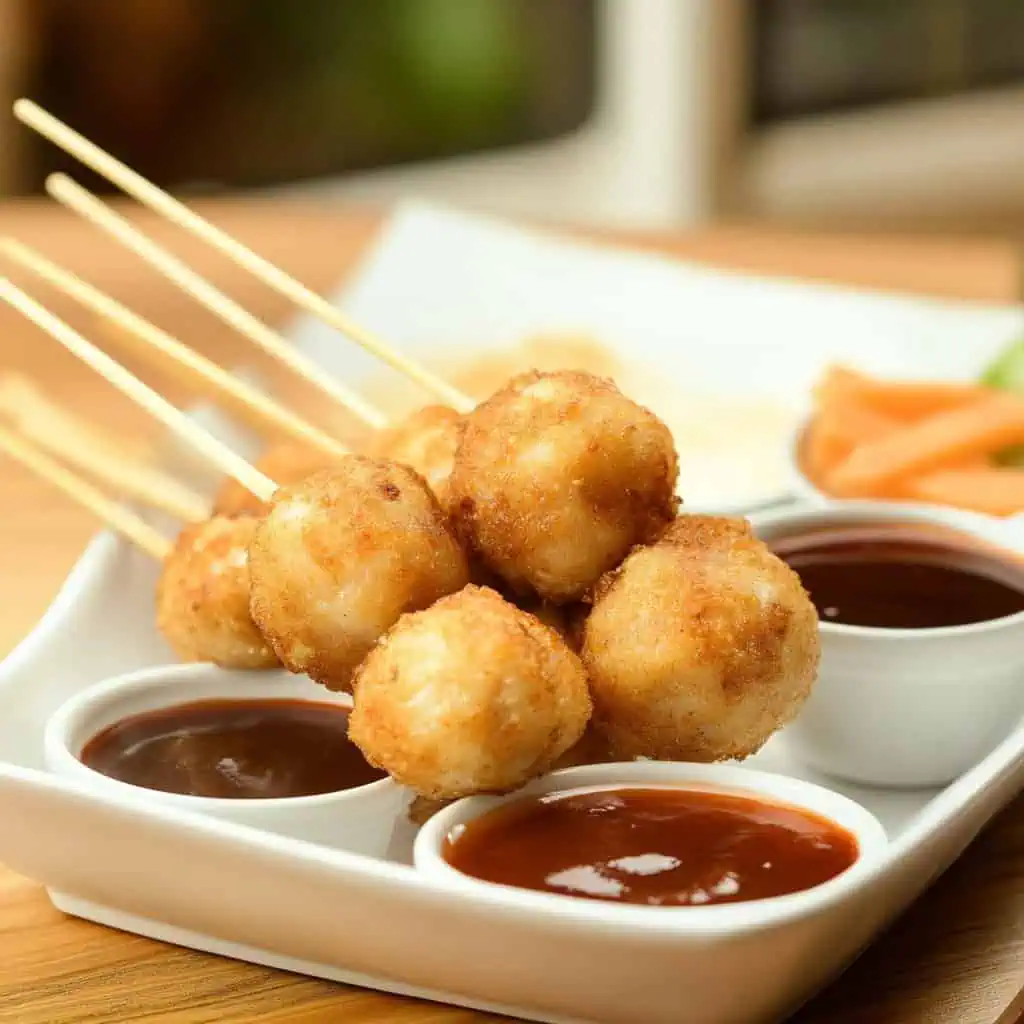





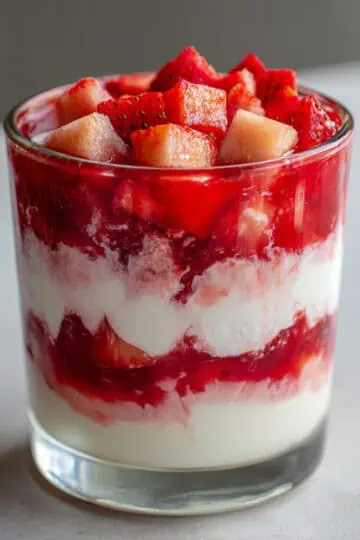



Comments
No Comments